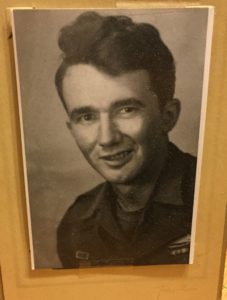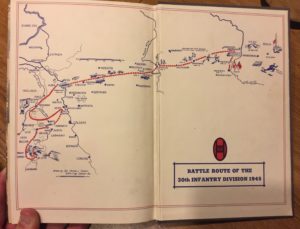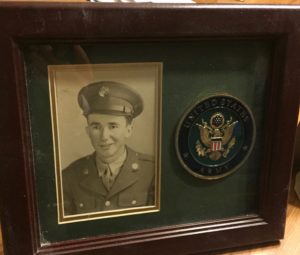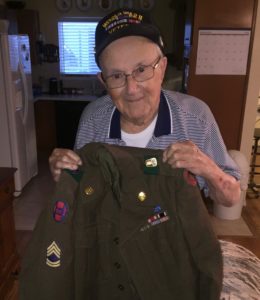Twice-wounded Infantryman’s Memories
Use controls above or click here to open this Hometown Heroes podcast in a new window
94-year-old Roger Bain of Las Vegas, NV appears on episode #619 of Hometown Heroes, airing March 12-16, 2020. A native of Rhinelander, WI, Bain served with Company I, 120th Regiment, 30th Infantry Division in Europe during World War II.

Roger Bain enlisted in the Army after graduating from high school. For more photos, visit the Hometown Heroes facebook page.
Roger’s father, who had been wounded while serving in the Army in World War I, was helping to build a hydroelectric dam on the Wisconsin River, so Roger’s earliest memories involve a “primitive” existence with no electricity in the home. Even when the dam was finished, and the Bains left their oil lamps behind and moved into town, there was no refrigerator. You’ll hear him remember December 7, 1941 and how he learned of the attack on Pearl Harbor, as well as the news later that young men from his small hometown had become casualties of the war. Peter Makris became the first Rhinelander native killed in World War II when he was lost with the cruiser USS Houston (CA-30) in March, 1942. American Legion Post #7 in Rhinelander now bears his name, along with that of Abner Dahlberg, who had been killed in World War I. Roger had known Peter Makris in high school, not to mention others who had been killed before Roger enlisted in 1943. He went to sign up along with three of his classmates, and was soon headed to Arkansas for training.
“I wasn’t afraid of the service,” you’ll hear Bain explain. “I think the guys that interviewed me said ‘Here’s a dumb kid, let’s send him in the infantry.'”
He had grown up hunting deer, partridges, and ducks in northern Wisconsin, so his marksmanship was solid, but he had no idea what would be waiting for him overseas. Landing at Omaha Beach less than a week after the start of the invasion of Normandy, he would first experience combat in northern France.
“You didn’t really want to get real friendly with anybody,” you’ll hear Bain explain. “Because you didn’t know how long they’d last. That was the hardest part of being in infantry.”
The 30th Infantry Division was the first American division to enter Belgium and the Netherlands, and it was involved in the capture of Aachen, the first major German city to fall to the Allies, in October, 1944. By December, Roger found himself in the vicinity of Malmedy, Belgium. He had learned to endure enemy mortars, artillery fire, tree bursts, and more, and you’ll hear him remembers some of his close calls. You’ll also hear how a teenager who had dealt with 40-below-zero temperatures in Wisconsin kept his extremities warm during the Battle of the Bulge. Nothing however, could prepare him for the cold-blooded nature of the Malmedy Massacre, an atrocity to which he was in close proximity, in both time and distance. Listen to Hometown Heroes for Roger’s recollection of that tragedy’s impact, as well as his memory of the first time he was wounded on January 13, 1945.
“It knocked the leg out from underneath me,” he says of the shrapnel from a mortar shell that struck him. “But it didn’t hurt.”
While Roger slowly recovered in a hospital in Liege, his unit continued to battle the enemy for two more days. When more casualties arrived, they informed him that nearly his entire company had been “wiped out.” In his platoon, only the platoon guide had avoided being wounded.

Wounded in Belgium on January 13th, 1945, Roger did not return to his unit until after the 30th Infantry Division had crossed the Rhine River.
While he was away, the division had crossed the Rhine River and continued its eastward push in Germany. When he returned to his unit, he says he barely knew anyone. He would be wounded again, but you’ll hear him dismiss it as “just a little scratch” that “didn’t draw much blood.” He attributes his survival to “luck” and “the Good Lord,” and you’ll hear him describe other close calls, like the time a German tank fired a shell that destroyed a piece of furniture he’d been examining just moments before. You’ll hear his memories of witnessing survivors of the Holocaust, reuniting with his parents in Wisconsin, and even how he met his wife, Grace, after the war.
In recent years, Roger’s adventures have included throwing out the first pitch at a AAA baseball game in Las Vegas, and journeying to Washington, D.C. with Honor Flight Southern Nevada. He saw the World War II Memorial, as well as the monument to those fallen in the war in which his son fought in Vietnam, but nothing stirred his emotions quite like the Tomb of the Unknown Soldier. That memorial was commissioned in the wake of the conflict in which Roger’s father fought, World War I.
“I thought of my dad,” you’ll hear him say with his voice cracking, explaining how he got out of his wheelchair to stand at attention. “Here come two people to stand on each side of me, so I wouldn’t fall.”
As he approaches his 95th birthday, Roger says he’s proud of “making it through.” He once raced stock cars, and he spent 44 years in the electrical trade, once even holding a “Q Clearance” from the Department of Energy for his work on an atomic energy facility in Kentucky. Check out the videos below, one with Roger showing us his World War II uniform, and the other chronicling the exploits of the 30th Infantry Division in World War II as the “Work Horse of the Western Front.”
—Paul Loeffler




